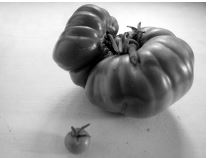 We are becoming increasingly used to changes in our climate which frequently undermine our best efforts to till the soil and enjoy the results. Our aubergines have been a striking example. They were planted in 20cm pots, in good rich soil-based compost, fed and watered regularly – but not too much – all snug and warm in the polytunnel, and what happened? Strong, well – grown plants with several glossy aubergines near the base, then, a lot of dead blossoms higher up, followed by some tiny new, pea-sized aubergines. It didn’t take a Sherlock Holmes to discover the probable cause. Adopting his methods, we deduce that the plants first experienced ideal weather and temperature during the early period – hence the well-grown fruits at the bottom of the plants. The withered blossoms higher up the stems showed the plants were now under extreme heat stress. Finally, the baby aubergines at the top showed they were able to set as the temperature cooled again. The keen-eyed sleuth would reinforce his theory by pointing to the fact that we’d had an exceptionally good crop of peppers and chillies, which originate in Mexico and South America and therefore, unlike aubergines, revel in as much heat as they can get. My Sherlock was an adviser for the RHS, who said that he’d had a similar problem in his polytunnel and had solved it by draping a large duvet cover over the tunnel in periods of extreme heat. Useful tip, assuming he knows what he was talking about.We have enjoyed some of the fruits of our labours in this strange year. Despite so many flowers and vegetables being late, or in short supply, we’ve never had such good crops of sweet peas. We didn’t have any for the annual Show on 7th August, but a few days later they’d gone amok. An unexpected result of the cooler weather which has stopped the plants from running to seed and giving us a bumper crop.
We are becoming increasingly used to changes in our climate which frequently undermine our best efforts to till the soil and enjoy the results. Our aubergines have been a striking example. They were planted in 20cm pots, in good rich soil-based compost, fed and watered regularly – but not too much – all snug and warm in the polytunnel, and what happened? Strong, well – grown plants with several glossy aubergines near the base, then, a lot of dead blossoms higher up, followed by some tiny new, pea-sized aubergines. It didn’t take a Sherlock Holmes to discover the probable cause. Adopting his methods, we deduce that the plants first experienced ideal weather and temperature during the early period – hence the well-grown fruits at the bottom of the plants. The withered blossoms higher up the stems showed the plants were now under extreme heat stress. Finally, the baby aubergines at the top showed they were able to set as the temperature cooled again. The keen-eyed sleuth would reinforce his theory by pointing to the fact that we’d had an exceptionally good crop of peppers and chillies, which originate in Mexico and South America and therefore, unlike aubergines, revel in as much heat as they can get. My Sherlock was an adviser for the RHS, who said that he’d had a similar problem in his polytunnel and had solved it by draping a large duvet cover over the tunnel in periods of extreme heat. Useful tip, assuming he knows what he was talking about.We have enjoyed some of the fruits of our labours in this strange year. Despite so many flowers and vegetables being late, or in short supply, we’ve never had such good crops of sweet peas. We didn’t have any for the annual Show on 7th August, but a few days later they’d gone amok. An unexpected result of the cooler weather which has stopped the plants from running to seed and giving us a bumper crop.
Tomatoes have been few and far between, although the first we picked weighed 1.2kg – enough to make soup for six! Runner beans have been disappointing, hit by slugs and hail, but a climbing French bean “Neckargold” has done well. It’s an unusual variety from the Real Seed Catalogue and unlike most beans is still tender when the pods are swollen. We’ve kept carrot root fly off the plants with fleece, and although there are no prize winners among them the taste is just as good – a revelation if you’ve only eaten supermarket carrots before.
Earlier in the year we pruned our box hedges and topiary to cut out blight. This has been mostly successful except for one hedge, which now has some dead patches. We didn’t cut this hedge as hard as the others – it seemed to be healthy – but obviously there was some blight lurking. (Caterpillars can also damage box, and the moth is now in our area, but we couldn’t see any signs of them or their excreta, so I think blight it is). So we cut out all the dead stems and gave the plants a spray of Top Buxus, which is sold as a tonic but also contains copper, which acts as a mild fungicide.
Now some garden jobs. It’s the ideal time to divide herbaceous perennials. These include: Agapanthus, Anemone, Aster, Bergenia (elephant’s ears), Convallaria (lily-of-the-valley) Crocosmia, Dierama, Delphinium, Epimedium, Eryngium (sea holly), Euphorbia, Gentiana (gentian) Geranium, Helianthus, Hemerocallis (daylily), Hosta, Iris, Lychnis, Lysichiton,
It’s fun – and profitable – to collect some of your own seeds, on a dry day, as soon as the seedheads ripen. You can tell when they’re ready by a colour change from green to brown, black or red, but must be before they open and shed their contents. We always collect seeds from the easy ones – sweet and edible peas, beans, tomatoes and our rare kale. You can be as ambitious as you like!
Ken Mines

